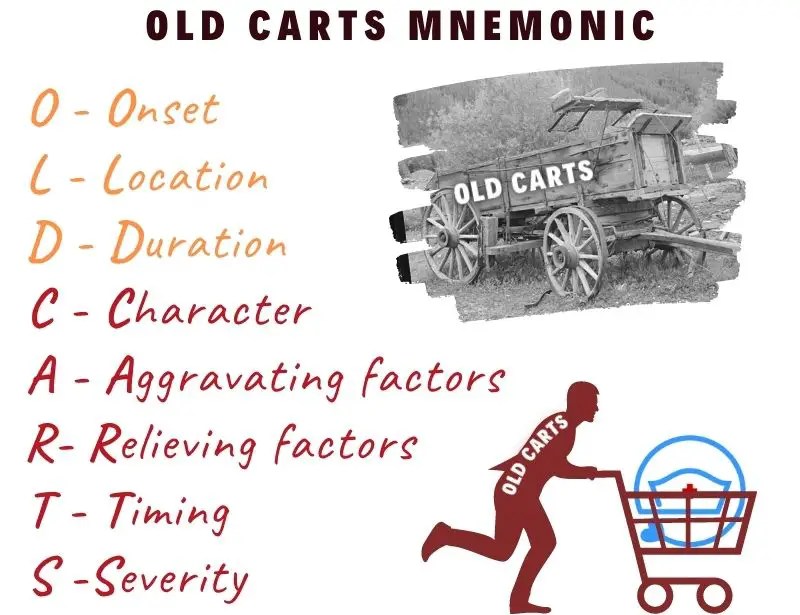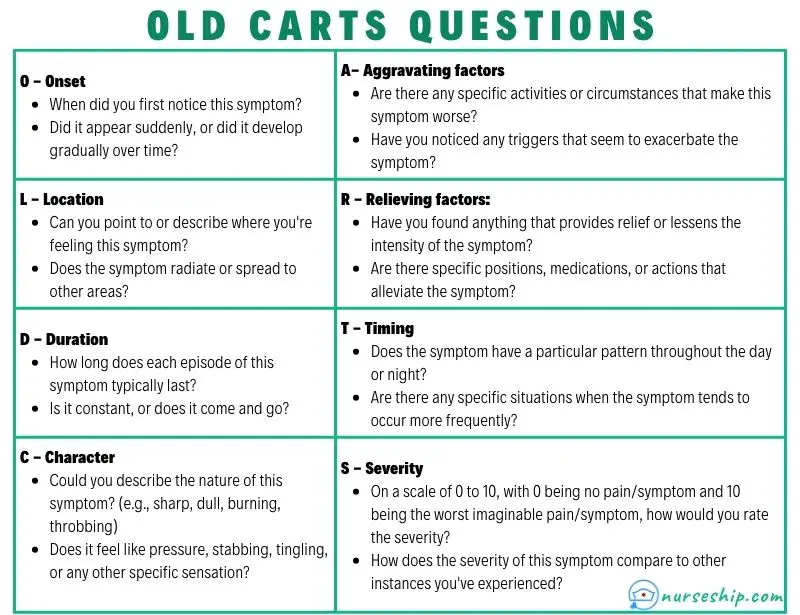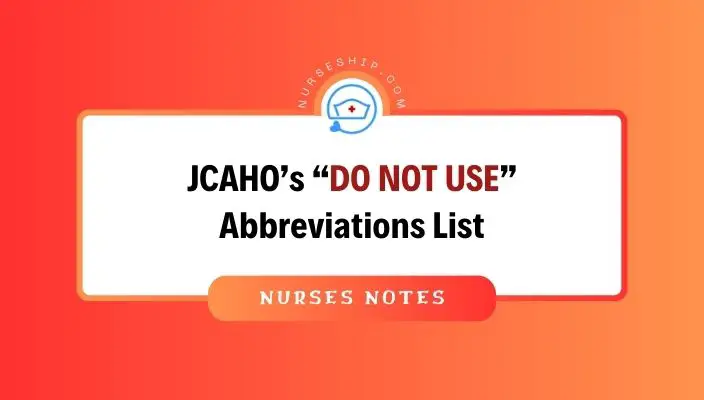There are several tools used in nursing assessments. “OLD CARTS” is one of those structured frameworks employed by nurses and clinicians to systematically determine a patient’s present illness, also known as the History of Present Illness (HPI).
Whether in a clinical setting or during patient history-taking, the OLD CARTS approach serves as a valuable instrument for comprehensive symptom evaluation, enhancing the quality of patient care and medical decision-making.
In this article, we will explain what the OLD CARTS acronym stands for and the questions you can ask when using the OLD CARTS mnemonic to assess the history patient’s present illness.
What Does OLD CARTS Acronym Stand For?

The ‘OLD CARTS’ stands for the acronym for Onset, Location, Duration, Character, Aggravating factors, Relieving factors, Timing, and Severity.
- Onset
- Location
- Duration
- Character
- Aggravating factors
- Relieving factors
- Timing
- Severity
This mnemonic technique offers nurses a structured framework for systematically gathering crucial information about a patient’s symptoms, facilitating accurate diagnosis and effective treatment planning.
Related: OLD CARTS vs. OPQRST
Examples of OLD CARTS Mnemonic Questions

“OLD CARTS” O – Onset
In nursing assessment, “Onset” refers to understanding when the symptom or condition began. Nurses inquire about the specific timing and circumstances surrounding the initial appearance of the symptom to determine its potential causes and triggers.
Following are some of the questions you can ask to determine the onset of the symptom.
OLD CARTS Questions for “O”
- When did you first notice this symptom?
- Did the symptom start suddenly, or did it develop gradually over a period of time?
- Have you experienced any changes in your lifestyle or routine around the time the symptoms began?
- How would you describe the initial sensations you felt when this symptom started?
- Can you recall any specific event or circumstance that might have triggered its onset?
“OLD CARTS” L – Location
“Location” involves identifying the precise area on the patient’s body where the symptom is being experienced. This information helps nurses to pinpoint the affected body part or system, aiding in accurate diagnosis and appropriate care planning.
Here are some of the questions you can ask to identify the location.
OLD CARTS Questions for “L”
- Can you point to the exact location where you’re feeling this symptom?
- Does the sensation stay in that location, or does it move or spread to other areas?
- Does the symptom occur in one specific place or is it felt throughout a larger area?
- How does the location of this symptom relate to any other symptoms you might be experiencing?
“OLD CARTS” D – Duration
“Duration” pertains to the length of time the symptom has been present. Nurses ask patients about how long each episode of the symptom lasts and whether it occurs intermittently or consistently, helping to gauge the symptom’s acute or chronic nature.
Following are some of the questions you can ask to determine the duration of the symptom.
OLD CARTS Questions for “D”
- How long does each episode of this symptom usually last?
- Is there a consistent timeframe for how long the symptom persists each time it occurs?
- Have you noticed any changes in the duration of the symptom since it first started?
- Does the symptom have a tendency to come and go, or does it remain constant?
- Have you tracked the duration of the symptom, and if so, have you noticed any patterns over time?
“OLD CARTS” C – Character
Nurses explore the “Character” of the symptom to gain insights into its qualities, such as the type of pain, sensation, or discomfort the patient is experiencing.
This understanding assists nurses in differentiating between various potential causes and determining appropriate interventions.
Here are some of the questions you can ask to determine the characteristics of the symptoms.
OLD CARTS Questions for “C”
- Can you describe the sensation you’re experiencing in detail? (e.g., sharp, dull, burning, stabbing)
- Does the sensation feel like pressure, tingling, throbbing, or any other specific quality?
- How would you compare this sensation to any other discomfort or pain you’ve felt before?
- Are there any words or images that come to mind when you try to characterize the feeling?
- Has the character of the symptom changed at all since you first noticed it?
“OLD CARTS” A – Aggravating Factors
In nursing assessment, “Aggravating Factors” involve identifying activities, situations, or triggers that worsen the symptom.
Nurses ask patients about what exacerbates the symptoms to avoid these factors and tailor care plans accordingly.
Here are some of the questions you can ask to identify the aggravating or worsening factors.
OLD CARTS Questions for “A”
- Are there any specific activities or movements that seem to make the symptom worse?
- Have you noticed any environmental factors that tend to worsen the symptom?
- Does the symptom intensify in certain positions or postures?
- Are there any external factors, such as temperature or humidity, that contribute to the symptom’s aggravation?
- Can you identify any triggers that consistently lead to an increase in the symptom’s severity?
“OLD CARTS” R – Relieving Factors
Nurses inquire about “Relieving Factors” to understand what actions, interventions, or conditions alleviate or reduce the symptoms.
This information helps nurses recommend strategies for symptom management and patient comfort.
Following are some of the questions you can ask to understand relieving factors.
OLD CARTS Questions for “R”
- Are there specific positions or postures that provide relief from the symptom?
- Have you noticed any particular activities that temporarily alleviate the symptoms?
- Do certain medications or treatments seem to reduce the intensity of the symptom?
- Are there any environmental changes, like temperature or lighting, that lessen the discomfort?
- Have you found any self-care strategies, such as relaxation techniques, that help alleviate the symptoms?
“OLD CARTS” T – Timing
“Timing” refers to when the symptom occurs or varies throughout the day or in relation to specific events.
Nurses ask patients about patterns in the symptom’s timing to better understand its potential causes and implications.
Here are some of the questions you can ask to determine the timing of the symptom.
OLD CARTS Questions for “T”
- Are there specific times of day when the symptom tends to occur more frequently?
- Does the symptom have any association with your daily routine, like waking up, meals, or physical activity?
- Have you noticed any patterns in the timing of the symptom’s onset or exacerbation?
- Does the symptom occur in relation to any external events or triggers, like stress or certain environments?
- How long does the symptom typically persist during each occurrence, and is there variation in its timing?
“OLD CARTS” S – Severity
Assessing “Severity” involves gauging the impact of the symptom on the patient’s well-being and daily functioning.
Nurses use tools like pain scales to understand the intensity of the symptom and its effect on the patient’s quality of life.
Here are some of the questions you can ask to determine the severity of the symptoms.
OLD CARTS Questions for “S”
- On a scale of 0 to 10, with 0 being no discomfort and 10 being the most severe pain you can imagine, how would you rate the intensity of the symptom?
- How does the symptom’s severity impact your ability to perform daily activities and tasks?
- Has the symptom’s severity changed since you first noticed it, and if so, how?
- Can you describe a recent instance when the symptom was at its worst in terms of severity?
- In comparison to other discomforts you’ve experienced, where would you place the severity of this symptom?
See Also:
Conclusion
The OLD CARTS acronym serves as a valuable framework, enabling nurses to comprehensively gather information about a patient’s symptoms and provide holistic, patient-centered care.
By guiding healthcare providers through various aspects of the symptom experience, OLD CARTS offers valuable insights into the underlying causes and potential implications of the patient’s condition.
We hope that the examples of the OLD CARTS mnemonic and questions in this article made it easier for you to remember and apply during the nursing assessment.




